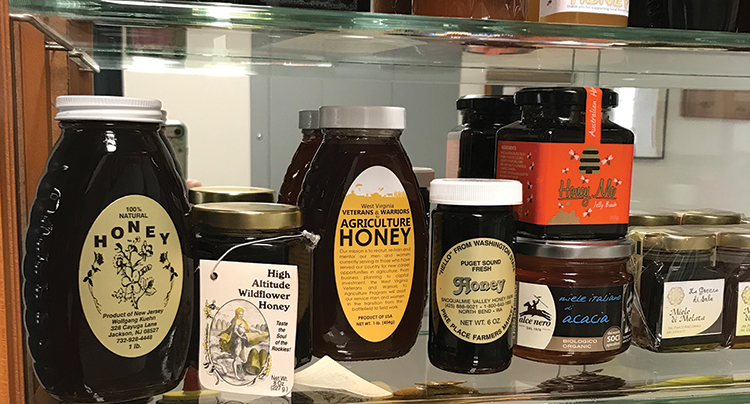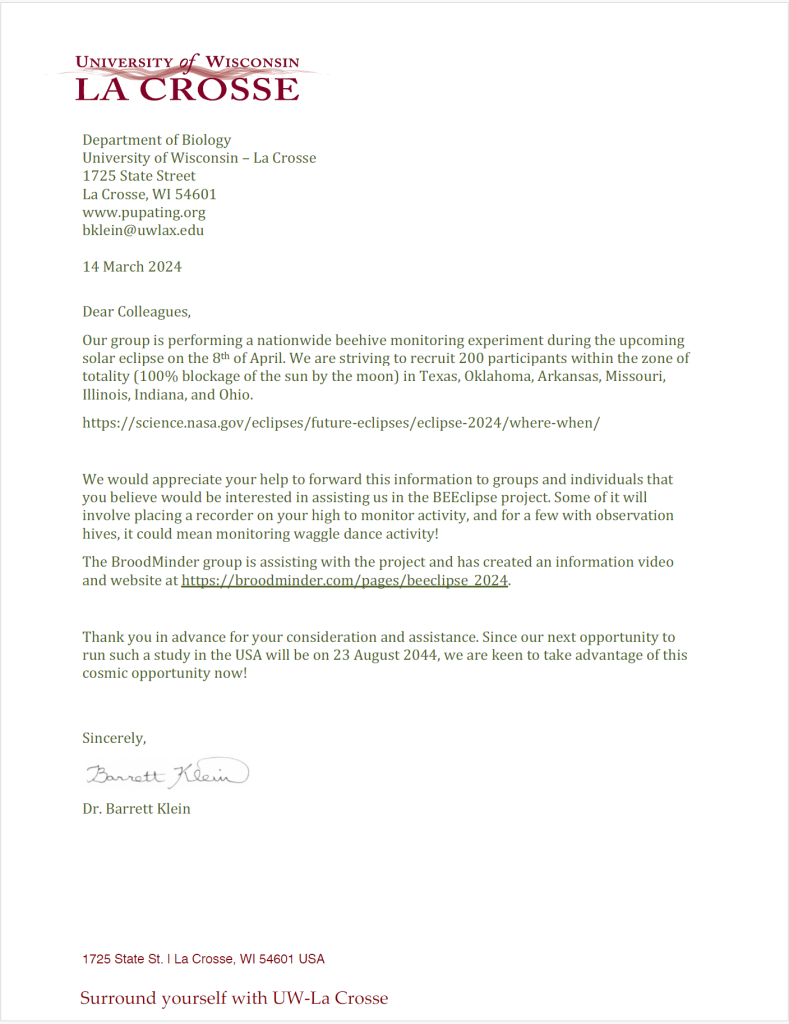Keeping Your Honey Waiting
By: Jay Evans
As a scientist, I notice and tuck away lots of recent articles on topics that relate to research by myself and others here at the USDA-ARS Bee Research Lab. This column pushes me to stop in my tracks and read more articles on topics way outside my usual interests. So it was with an upcoming article in ‘Food Chemistry’ by Ioannis Pasias and colleagues in Greece “Effect of late harvest and floral origin on honey antibacterial properties and quality parameters” (https://doi.org/10.1016/j.foodchem.2017.09.083). To be honest, this title jogged memories of pulling frames from a neglected deadout, extracting honey and, much later, musing that the honey tasted a bit funky. As a hobbyist, somewhat funky honey is acceptable to my (non-paying) customers. In fact, friends will never tell you to your face that your honey tastes funky, even as they purse their lips and agonize over gentler words to describe it. Since I have a reputation to maintain, I draw the line at not poisoning anyone. The Pasias article promised to say, for one class of honey, whether anything dangerous might arise from such ‘late harvest’ honeys.
Pasias and his Argonauts measured the physico-chemical traits of 38 honeys collected from a region of Greece. Their main focus was on two collections from the same beekeeper and apiary. One of these, ‘Early Argos’, consisted of four honey samples extracted promptly at the end of the season. In contrast, honey for four ‘Late Argos’ samples remained in the comb in closed boxes for an additional year. All 38 honeys, along with three samples of Manuka honey from New Zealand, were subjected to a battery of tests, measuring everything from antimicrobial activity to levels of 5-Hydroxymethylfurfural (HMF) and diastase. HMF is a standard for estimates of honey aging and temperature spikes. In the end, HMF levels were substantially higher in the ‘late’ samples when compared to both fresh extracted samples from the same site (>12-fold higher) and 30 local honey samples purchased at markets (3x higher on average). Interestingly, the ‘late’ honey also showed greater antimicrobial properties than the early samples. In fact the stored honey also showed two-fold higher antibiotic activity towards bacteria than did the famous Manuka honey. This is counterintuitive since it is generally believed that antimicrobial traits of honey diminish over time, even as honey itself can last many hundreds of years when undiluted. The Greek study had a weakness in that palynological analyses revealed the stored ‘late’ honey came from somewhat different floral sources than the ‘early’ sample. While the HMF levels and antimicrobial traits of this late honey were higher than any of the other polyfloral honeys form the area, it is not possible to say for certain how much of this difference was due to aging in the field versus a difference in sources – so onward to finding a better source.
As honey producers know, there is an extensive literature on the effects of heat and storage on honey traits. Dr. Clarence Collison wrote an excellent review on this in Bee Culture, adding an analysis of the various ways that sugar supplements can be detected in honey (https://www.beeculture.com/a-closer-look-feeding-sugar-syruphmi/). The increase in HMF (the best-known adverse honey component) is not particularly fast for bottled honey, maybe an increase of three ppm per month on the high end. On the legal side, honeys subjected to high heat, or lengthy storage, might run afoul of international standards for HMF and the loss of diastase activity (fao.rg/input/download/standards/310/cxs012e.pdf). Allowable levels for retail honey are under 40 ppm HMF and over eight Schadwe units diastase activity, with some exceptions. For one, these standards are relaxed to 80 ppm for honeys with naturally high HMF levels, including Manuka honey and tropical polyfloral honeys.
The fastest route to high HMF levels in honey and in high fructose syrup fed to bees involves heat. Corn syrup stored at 40oC (104oF, admittedly quite warm) acquires HMF at a rate of 20 ppm per month while syrup subjected to temperatures of 49oC accumulates HMF at around 150 ppm/month (https://doi.org/10.1021/jf9014526). Honey likely behaves in a similar way. Light exposure has a significant impact on honeys that are already bottled and out in the open. Our own honey collection (see the photo) is full of samples that are significantly darker today than when they were first collected several years ago, showing the effects of a multi-year shelf life under fluorescent lighting. More studies are needed to determine adverse effects of light exposure on bottled honeys, although there is reason for concern since HMF is in fact a product of darkening in the form of the Maillard reaction.
You may be wondering if HMF or other degradation products in stored honey will impact your bees when honey frames are recycled back into hives. Zirbes and colleagues in Belgium have taken some of the guesswork out of that, by reviewing levels at which HMF impacts bees directly (https://doi.org/10.1021/jf403280n). Based on this, a downside to moderately aged honey for bees seems unlikely. Assuming HMF accumulation occurs at a rate of three ppm-month, it would take three years to approach 100 ppm in honey, and the first signs of negative effects in bees tend to occur above that. In a very careful study involving worker bees, Blaise LeBlanc and colleagues showed a significant adverse impact of HMF in corn syrup at concentrations exceeding 250 ppm (https://doi.org/10.1021/jf9014526), while Sophie Krainer and colleagues did not see adverse effects of HMF on bee larvae until levels in brood food were > 2000 ppm (https://doi.org/10.1007/s10646-015-1590-x). On the other hand, HMF could interact with the other stresses facing bees, including other honey traits impacted by age and temperature. Leslie Bailey, a great, and recently deceased, bee scientist, suggested this very thing over 50 years ago. He showed that honeys stored four and eight years had negative effects on caged bees fed this as their sole food source (https://doi.org/10.1080/00218839.1966.11100146). HMF levels in these honeys were not likely to be toxic, but other degradative processes seem to have had a cumulative effect that was bad for bees. Overall, storing honey in the dark at moderate temperatures for months and even years seems a good bet for bees as well as humans. On the other hand, if you neglect these boxes for several years, and if waxmoths, mice, and beetles do not ravage them first, the resulting honey could be toxic for your bees.
Along with the usual U.S. government disclaimer that I cannot tell readers whose honey or syrup to buy, I want to make perfectly clear that I am NOT a food chemist, nor a food safety expert, so any insights related from these studies should be taken with caution with respect to food quality, palatability, or risk (eater beware!). Hopefully the cited studies will help those who want to explore the traits of aging honey in more detail. I, for one, will keep consuming, funky taste or not.










